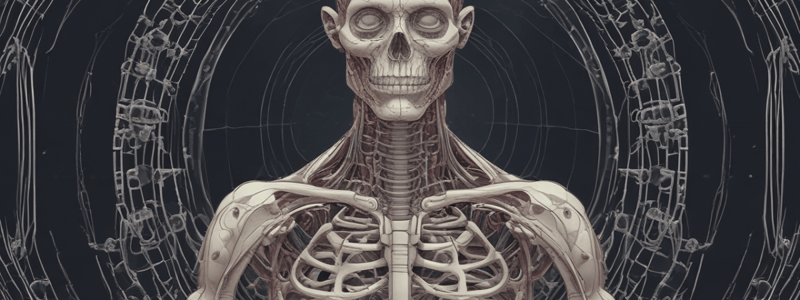Podcast
Questions and Answers
What is the primary function of the circulatory system?
What is the primary function of the circulatory system?
- To circulate blood around the body and deliver oxygen and nutrients to organs and cells (correct)
- To influence the function of the body using hormones
- To defend the body against pathogens
- To absorb nutrients and remove waste
Which system eliminates waste from the body?
Which system eliminates waste from the body?
- Integumentary system
- Circulatory system
- Muscle system
- Digestive system and Excretory system (correct)
What is the main function of the endocrine system?
What is the main function of the endocrine system?
- To circulate blood around the body
- To influence the function of the body using hormones (correct)
- To defend the body against pathogens
- To absorb nutrients and remove waste
Which system comprises a network of lymphatic vessels that carry a clear fluid called lymph?
Which system comprises a network of lymphatic vessels that carry a clear fluid called lymph?
What is the study of the structure and relationship between body parts called?
What is the study of the structure and relationship between body parts called?
How many important organ systems make up the human body?
How many important organ systems make up the human body?
What is the function of the integumentary system?
What is the function of the integumentary system?
What is the main function of the immune system?
What is the main function of the immune system?
What is the primary function of the circulatory system?
What is the primary function of the circulatory system?
What is the location of the heart in the human body?
What is the location of the heart in the human body?
What is the purpose of the valves in the heart?
What is the purpose of the valves in the heart?
What is the name of the upper chambers of the heart?
What is the name of the upper chambers of the heart?
What is the duration of the atria filling with blood during diastole?
What is the duration of the atria filling with blood during diastole?
What is the name of the muscle that makes up the heart walls?
What is the name of the muscle that makes up the heart walls?
What is the purpose of the septum in the heart?
What is the purpose of the septum in the heart?
What is the duration of atrial systole?
What is the duration of atrial systole?
Flashcards are hidden until you start studying
Study Notes
Anatomy and Physiology
- Anatomy is the study of the structure and relationship between body parts
- Physiology is the study of the function of body parts and the body as a whole
Body Systems
- The human body consists of 11 important organ systems
- These systems work together to maintain a functioning human body
Organ Systems
- Circulatory system: circulates blood, delivers oxygen and nutrients, and carries waste products away
- Digestive system and Excretory system: absorbs nutrients and removes waste
- Endocrine system: influences the function of the body using hormones
- Integumentary system / Exocrine system: includes skin, hair, nails, sweat, and other exocrine glands
- Immune system and lymphatic system: defends the body against pathogens and comprises a network of lymphatic vessels
The Circulatory System
- Also known as the cardiovascular system or vascular system
- Permits blood to circulate and transport nutrients, oxygen, carbon dioxide, hormones, and blood cells
- Maintains a constant circulation of blood around the body
- Helps to stabilize temperature and pH
The Heart
- A muscular organ that pumps blood through the circulatory system
- Located between the lungs in the middle compartment of the chest
- Composed of cardiac muscle that has its own inherent rhythm and does not get tired
- Divided into four chambers: two atria and two ventricles
- Valves are present between each atrium and ventricle and in pulmonary artery and aorta to ensure blood flows in one direction
Heart Function
- Atria and ventricles relax together (diastole) and fill with blood from the anterior and posterior vena cavae and pulmonary vein
- Blood flows into the ventricles, taking 0.4 seconds
- Atria contract together (atrial systole) and force any remaining blood into the ventricles, taking 0.1 seconds
Studying That Suits You
Use AI to generate personalized quizzes and flashcards to suit your learning preferences.



